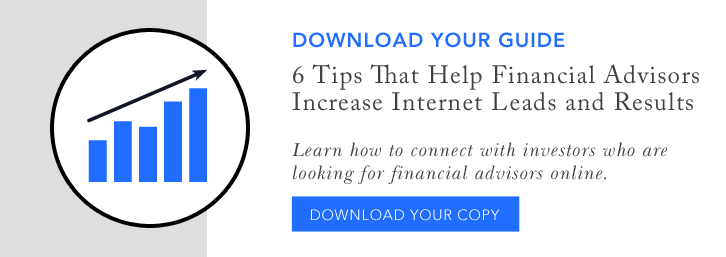

How Can Smaller RIAS Add More New Clients
Editor's note: This blog article was originally published in 2017 and has been updated for accuracy and comprehensiveness.
New client acquisition for many RIAs, especially the thousands of firms with less than $100 million of AUM, is a frustrating experience that negatively impacts the growth of their firms. Successful marketing strategies are virtually non-existent, which forces these firms to rely on market appreciation and a trickle of referrals to help offset normal client attrition and produce business growth as measured by AUM.
In fact, the performance of the markets during the past ten years has masked the trickle of new clients with market appreciation, reinvested income, and new money from current clients. But, as they say, the good times will not last forever. Eventually, RIAs will have to add new clients to achieve some level of organic growth.
The good news is the Internet provides an affordable way to expand the number of clients that are served by smaller, boutique RIAs. That’s because the Internet does not care about the size of firms. It prioritizes visibility based on a different set of criteria. The Internet’s productivity is measured by the results that are produced by the digital marketing strategies that produce online visibility, website traffic, and websites that convert more visitors into qualified leads.
New Client Growth Does Not Have To Go Sideways
Statistics show a picture of near-stagnation for many smaller RIAs. According to the Fidelity RIA Benchmarking Studies, organic growth for these firms has been declining for years. The biggest reason for the drop from prior years was a decline in the acquisition rate for new clients and AUM from current clients.
According to the studies, this stagnation can be attributed to several factors:
-
Buying businesses or clients may provide a source of asset growth, however, taking on another business can come with a high cost. Cultural differences may materialize. There is also no guarantee that the legacy clients will stay with the buyer.
-
Market appreciation increases AUM, but financial advisors have no control over these forces. One material down year can offset years of asset growth.
-
Many RIAs use lead-generation services. The problem is that these leads are not exclusive and investors may submit data on multiple websites. You’re not the only one at the dance, so to speak. The market for these leads is intensely competitive. It can be a matter of who gets to the lead first.
-
Relying on referrals for business growth has its downside. There may be very few of them and you still have to win the relationships. A small percentage of advisors receive enough referrals to offset losses and produce positive growth each year. This is a passive sales strategy that surrenders control of the pipeline.
At this point, an active digital-marketing strategy isn’t just a “nice to have” strategy for smaller RIAs. It is a relative necessity to compensate for client attrition year-to-year and produce positive client growth. Replacement is real - there is no guarantee that clients will stay with RIAs forever. They die, relocate, and terminate relationships for any number of reasons. In order to grow, RIAs need a sustainable, affordable method for adding new clients that doesn’t depend on the performance of the stock market. Although both are nice to have.
More investors are using the Internet to find professionals who can help them plan their financial futures and invest their assets. Your digital marketing strategy has to be competitive so they contact you.
The Power of the Internet for RIAs
According to the Fidelity RIA Benchmarking Study, RIAs were still behind the curve when it comes to digital marketing. More than half of them still did not have a strategy in place or know how to develop an effective one. That’s because they have relied on outbound marketing tactics (telemarketing, direct mail, networking) for decades. Less than one-third of firms even knew very much about digital marketing principles.
Success on the Internet is not based on size or AUM. It is based on your commitment to a digital marketing strategy.
Given the general lack of activity, the opportunity is ripe for smaller RIAs that want to create a marketing advantage for themselves. The Internet is leveling the playing field and can be a very equalizing force for RIAs that can afford digital marketing. It is the powerful punch they need to get the jump on the bigger firms.
Let’s look at what an RIA needs in order to develop a productive digital marketing experience.
-
A digital marketing strategy – Most RIAs don’t have one. Given the economics of a small RIA firm, the pockets for this type of spending aren’t very deep. In an effort to pinch pennies, most RIAs will throw money at a wide range of marketing tactics that don’t work – AdWords, template-based websites, drip systems. But this is foolish. RIAs need marketing strategies that produce positive ROIs.
-
A quality website – Many financial-advisor websites are saying the same thing with little differentiation from one to the next. Moreover, they are laden with distractions and boring content that turns off would-be clients. Being able to convert Internet traffic into leads depends on the website’s ability to increase visitors’ time on the site and compel them to give up their anonymity and submit their contact data.
-
Content marketing – In order to produce relevant white papers, articles, or blogs that people will actually read, content must be produced by a professional-caliber writer who understands investors and the business of the RIA. To be effective, the content must meet Google standards for original content and number of words (1,000+) and be something that investors actually open and read.
-
Social media – Someone must post content to the firm’s social sites and monitor any engagements or indications of interest. Free offers should also be integrated into your social strategy.
-
SEO – Advisors can take advantage of high ranks in Google results for hundreds of long-tail keywords that investors use to find financial advisors. For example, “Financial Advisor Dallas Texas CFP.” Or the keywords can relate to a question that leads an investor to an advisor who can provide the answer: “Can I donate to a charity to avoid capital gains taxes?”
-
Local SEO – This is the low-hanging fruit. It is easier, faster, and less expensive to increase RIA visibility in local markets. This directory-based strategy also impacts the RIA’s visibility on Google.
Why Outsourcing Makes the Most Sense
Most smaller RIAs don’t have the in-house resources to develop, implement, and manage an effective digital marketing campaign on their own. The cost of hiring an in-house team with all of the specialized skills would be prohibitively expensive.
Moreover, many advisors are discouraged by failed attempts at Internet marketing in the past. Typical experiences include low Internet visibility, low traffic-flows to websites, and their website’s failure to convert traffic into leads. While this is unfortunate, it’s not unfamiliar to digital marketing agencies that serve B2Cs and B2Bs’ inside and outside the financial services industry.
As the old saying goes, digital marketing is a marathon and not a sprint. But, the effort will produce new clients for years into the future.
Outsourcing to an experienced team of professionals who have successfully developed and implemented digital-marketing-based lead-generation platforms is a less expensive solution, but it is certainly not cheap. It takes a lot of specialized knowledge to be successful. On the other hand, an investment in digital marketing can pay for itself in the first year – all it takes is a few new clients. If you look at revenue based on what is produced for the life of the relationship, sometimes it only takes one or two new clients per year.
The $800 Million Digital Marketing Success Story
There once was a financial advisor who lived in a shoe, and had so many digital-marketing leads that he didn’t know what to do …
For the advisors reading this article who are unconvinced digital marketing works, here’s an advisor success story. This advisor has $800 million in AUM and has never met 80% of his clients face-to-face.
Not only did he master digital marketing, but he also mastered virtual marketing that he used to convert leads into clients.
How is this possible? He built visibility on the Internet by hiring an agency that consistently wrote and published high-quality content that resonated with investors. He even utilized the agency’s resources to write a book that he used to increase his credibility for providing expert financial advice. Then he used SEO marketing tactics to increase the visibility of his blogs, articles and white papers. Lastly, his website was designed to produce leads.
The results were 16 new clients per year that produced approximately $80,000 of new revenue for a digital-marketing expense that was less than $50,000 per year. But that is the tip of the proverbial iceberg. The new clients produced revenue year-after-year for as long as the advisor retained the relationships.
Digital marketing works, but it is not for the faint of heart. It takes the right strategy, a marketing budget, a team of experts, and perseverance to be successful.
Summing it up: Making the Investment Work
Spending money on marketing isn’t an RIA’s favorite thing to do, but it’s the only way to break out of a less than desirable low growth cycle. Given the limited upside of outbound alternatives (telemarketing, direct mail, networking, etc.), digital marketing is an investment that pays dividends for smaller RIAs for years. And, it can be a great equalizer when smaller firms have to compete with larger firms.
Digital marketing is an investment that produces continuous revenue for years.
The digital marketing equation is simple: Internet visibility produces traffic, traffic produces leads, and leads produce new clients and revenues.

Jack Waymire, BA, MBA
Search Here
Categories
- AI (18)
- blogging (2)
- branding (1)
- content (12)
- custodians (1)
- Digital (345)
- email marketing (3)
- fcmo (2)
- fees (1)
- financial advisor marketing (62)
- Google (3)
- Ideas & Tips (78)
- Investor Experience (7)
- lead generation (7)
- linkedin (1)
- Marketing (371)
- newsletters (1)
- Online Transparency (2)
- search engine optimization (3)
- seo (9)
- Social Media (2)
- video (2)
- Websites (108)
- YouTube channel (2)
Recent Posts
-

-

How Financial Advisor Blogging Generates Thought Leadership and Leads
November 24, 2025 -

Top 5 Ways Digital Marketing Benefits Financial Advisors Seeking Leads
November 20, 2025 -

Trust Is The Biggest Online Marketing Challenge For Financial Advisors
November 17, 2025 -

Compliant Financial Advisor Bios Using AI Website Builders
October 22, 2025

